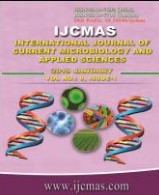


 National Academy of Agricultural Sciences (NAAS)
National Academy of Agricultural Sciences (NAAS)

|
PRINT ISSN : 2319-7692
Online ISSN : 2319-7706 Issues : 12 per year Publisher : Excellent Publishers Email : editorijcmas@gmail.com / submit@ijcmas.com Editor-in-chief: Dr.M.Prakash Index Copernicus ICV 2018: 95.39 NAAS RATING 2020: 5.38 |
In Benin, yam (D. cayenensis- D. rotundata complex) hold a prominent position in the diet and economic sector. Dry rot caused by Scutellonema bradys is one of the major concerns affecting diversity and resulting in significant losses to farmers. To assess the current cultivar diversity in the traditional agriculture and the importance of the cultivars perceived by the farmers as tolerant to tuber dry rot caused by the nematode Scutellonema bradys, 42 villages and six major markets were randomly selected from the four known yam diversity zones in Benin and surveyed using participatory rural appraisal. The results still revealed the presence of great yam diversity in Benin hence rejecting the statement of previous study according to which they will be a strong degradation of cultivar diversity in Benin by 2017-2018 with probably severe consequences on the food security of the population. Subject to synonymy, 640 cultivars were recorded. The number of cultivars varied from 4 to 39 per village (22 on average). The Shannon diversity index was 5.28 bits. In comparison with the study conducted five years ago, no significant reduction in the total number of cultivars per village was noted. Out of the existing diversity, only 10 cultivars morphologically distinct (UPGMA cluster Analysis) are perceived as tolerant to nematode and were even absent on the markets surveyed as they have no market value. Considering the scarcity of the yam cultivars tolerant to nematodes and the necessity to have a regional pool of such genotypes for the improvement of market varieties, the extension of such study to the other countries of West Africa yam belt is recommended.
 |
 |
 |
 |
 |